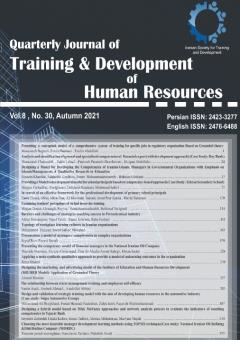-
-
List of Articles
-
Open Access Article
1 - Presenting a conceptual model of a comprehensive system of training for specific jobs of the supervisory organization Based on data theory
Masoomeh Bagheri Fardin Batmani Fardin Abdollahi -
Open Access Article
2 - Barriers and Challenges of Managers Coaching Success in the Petrochemical Industry
Akbar Hassanpoor Yusuf Vakili Saeed Jaafari Nia Raha Farhadi -
Open Access Article
3 - Designing a Hybrid Model Based on Mick McFuzzy Approaches and Network Analysis Process to Evaluate the Indicators of Coaching Competencies in Tejarat Bank
Seyedeh Zobeideh Falaki Kolori Sirous Tadbiri Ali Reza Afsharnejad Maryam Majidi -
Open Access Article
4 - Choosing the Most Desirable Manager Development Learning Methods Using TOPSIS Technique(Case study: National Iranian Oil Refining & Distribution Company (NIORDC)
Yasamin Javadi Mahdieh Asadi Hamidreza Yazdani -
Open Access Article
5 - Applying a Meta-Synthesis Qualitative Approach to Provide a Model of Unlearning Outcomes in the Organization
Roya Shakeri -
Open Access Article
6 - Analysis and Identification of General and Specialized Competencies of Financial Expert with Development Approach (Case Study: Day Bank)
Mansoureh Chahardoli Zahra Lebady Fatemeh Parasteh-Ghombavani Mojgan Abdollahi -
Open Access Article
7 - In Search of an Effective Framework for the Professional Development of Primary School Principals
Esmat Elzami Abbas Abbaspour Ali Khorsandi Taskoh Javad Pourkarimi Hamid Rahimian -
Open Access Article
8 - Design and Validation of Strategic Training Model to develop Human Resources in the Automotive Industry (Case study: Saipa Automotive Group)
Mohamad ali Borjikhani avanaki Esmat Masoudy Nadoshan Zahara Taleb Naiereh Shahmohammady -
Open Access Article
9 - Presenting a Model of managers' Competencies in Complex Organizations
Seyed Reza Razavi Saeedi -
Open Access Article
10 - The Relationship between Stress Management Training and Employees Self-Efficacy
Nasrin Asadi Amineh Ahmadi Assadollah Abbasi -
Open Access Article
11 - Typology of Workplace Learning Cultures in Iranian Organizations
Saeid Safaei Movahhed Mohammad Hajizad -
Open Access Article
12 - Presenting the Competency Model of Financial Managers in the National Iranian Oil Company
Ali Reza Afsharnejad Marziyeh Shabani Zeinolabedin Amini Sabegh Ehsan Sadeh -
Open Access Article
13 - Designing a Marketing and Advertising Model of the Institute of Education and Human Resources Development
Ahmad Shanian Reza Shafei Tohfeh Ghobad Lamuki Behrooz Bayat Marzieh Bayat -
Open Access Article
14 - Designing a Model for Developing the Competencies of Iranian Managers in Governmental Organizations with Emphasis on Islamic Management: A Qualitative Research in Education
Hossein Khanifar Salahedin Ebrahimi Faeze Mohammadesmaeely Bahman Gholami -
Open Access Article
15 - Providing a Model to develop a model for school principals based on a competency-based approach (Case Study: Tehran Secondary School
Mozhgan Farhadfar abolghasem delkhosh kasmayi Mahmoud Safari -
Open Access Article
16 - Examining teachers' Perceptions of Virtual in-Service Training
Peyman Yarmohamadzadeh Behbood Yarigholi Marjan doostI Alvanegh
-
The rights to this website are owned by the Raimag Press Management System.
Copyright © 2017-2025







